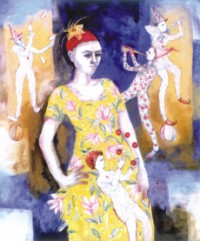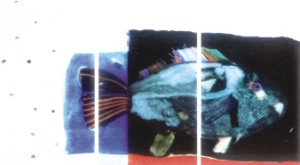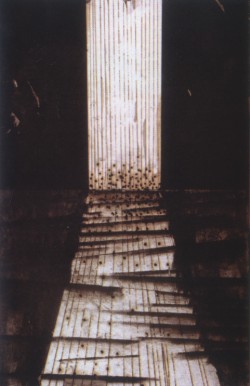|
Art
Marching on with new Colours
Fayza Haq
 |
Fareha Zeba, Germination 1, acrylic on canvas, 2010.
Photo: courtesy |
"Rooted Creativity -8”, which started on February 4 and ends February 11, is another extravaganza of artists of different generations expressing their idea of life and reality, experimenting with new techniques yet retaining their basic identities. The eighth phase of this series which is part of Bengal Foundation's 10th anniversary celebration, again brings forth the remarkable diversity in artistic talent of this land.
Fareha Zeba, a senior art teacher at Scholastica for decades, and an experimental artist, feted by her senior teachers of the Faculty Fine Art, University of Dhaka, dwells on the development of her style and subject. She speaks of the cause behind her change of the flamboyant gorgeous themes to more muted ones.
Zeba says that she is now more than ever, affected by the acute needs of women and children in particular– especially the abused and the abandoned ones. She is concerned with the superficial values of the Dhaka bourgeoisie, and attempts to stir her viewers, so that they become aware of the gravity of the gap between rich and poor and hence are moved to take some action.
“ My changes came 14 years back,” says Zeba, “It isn't as if I can't create contented images and themes. It's just that when I think deep about the problems of individuals and the society around me, and the vicissitudes of life in general, I have to restrain myself from lyrical landscapes or portraits laced with contentment. When, at that time, I saw a young woman with her acid burns on her face I was compelled to paint tormented face.”
Fareha points out that women suffer both in public and private spheres referring to women's personal struggles as well as being part of a public struggle for freedom as in the Independence war. The relative lull of the mid '70s political scenario is over, she says. Now, she says, the women are definitely more involved and motivated in all aspects and that leads to more complexities, suffering and frustrations. Similarly, economically too, women have gone forward in the career world: but the burdens on their shoulders have only increased, she insists.
Zeba's creation with the clowns, playing a musical instrument, singing , dancing and juggling around a central figure is a female clown in yellow. Pink flowers adorn her. Thrusts of upright male sex organs in the backdrop speak of a male dominated world, where the woman remains a second sex despite her talent and endeavours. The other paintings also carry woman as the main object, struggling against an unfair world. Layers of pale but buoyant colours set off the figures with their intricate messages of struggle and strife in a male dominated existence since beginning of creation. Foetuses are included in a third painting. However, this is not a revolting representation of the human body. Flowers , leaves and tendrils drape the main objects gently and carefully like some unfolding of a Christmas wrapping.
Laila Sharmeen, an established artist for a decade, in her poetic and scintillating, soft images and colours has taken printmaking many strides forward in Bangladesh. Willowy and sloe-eyed, she has a world poetry to rest on, along with the teaching of her teachers and other masters from overseas like Cy Twombly. In bringing in idyllic scenes of Bangladeshi village scenes full of flowers, waving paddy and mustard fields, the meandering rivers, the gorgeous buxom women, along with other birds and beasts, Sharmeen has stressed the need of mankind to return to nature .
 |
Kazi Rakib, Fish 2, glass etching and digital image, 2011. Photo: courtesy |
Inspired by Baudelaire, TS Eliot, Jiban Anada Das, the French impressionists, and the contemporary European and American artists, whose works she studied at the art galleries overseas, she turned more pages of art books which she brought home along with her. This added to the knowledge that she has gleaned over the years of her pouring over tomes containing information on world art and literature. Foreign exposure widens the horizons, one believes, and Sharmeen's trip to USA did just that.
Laila Sharmeen's little houses, boats, birds, banana trees , human beings amidst splashes of colours like cobalt blue, orange and gold with lines from poems and white soothing pristine white space beyond the colours and lines of calligraphy give the works a fairy-like touch.
Iffat Ara Dewan hopes to hold a solo in a month or so at Bengal. For Iffat dividing her time between singing and painting is not easy. She presents the interior of houses with plants, trees, fruit, blossoms, wicker chairs, cane chairs, paintings on the walls. They consist of dots, loops, and lines of different lengths. The colours used are pastel brown, pink and powder blue. Yellow and red hues are also included, as also black and gray. These are lyrical and contented images of a mind at ease with life. Iffat has included a landscape with gentle shades and soft lines. Mustard fields and houses have also been brought in the composition.
Iffat Ara Dewan's works were recently exhibited at the residence of Enam Ul Haque. She says she always had the compulsion to draw and paint but never really got started. One day, in 1990, she got hold of her child's crayons and pad and drew. She felt excited with the results and continued. She was asked to make the record cover of her LP and this gave her a further incentive to draw. After the selection for the cover, many drawings were left over, which were enough to make an exhibition in 1992.
Iffat is fond of flowers. She believes that they signify beauty and innocence in our life. "The colours generate excitement and the shapes are endearing. The fragrance also helps you to forget your disappointments and woes. I try to include a striking flower vase in the composition. The flowers carry a definite message.” Most of the flowers that Iffat brings in as her subjects are from her garden such as aparajita and dolonchanpa .
She does her artwork in between her singing and so sometimes there is a large gap.
Iffat has had seven solo exhibits, the last being at Shilpangan.
 |
Mohammad Fokhrul Islam, Image 4, oil on paper, 2009. Photo: courtesy |
Critiques have said that the "celebration of the richness" of Fokhrul Islam's thoughts, lend one courage and fortitude. It helps one to escape from the pervading life of the twenty-first century – the world over i.e.. The artist aids the viewer to lead his/her life with "courage and dignity". His cityscapes and nightscapes present denials and hopes –- in a dramatic and daring way. The artist is surely a unique "Pied Piper", presenting his songs of life. This is done with aplomb and an intrinsic romantic imagination. This is done by the inclusion of "The mirror and the lamp".
Yes, Fokhrul has included gloom and despair – but this is only to gently warn people of the dire consequences –so that mankind does not " rush in where angels fear to tread". Studying the manner of his series of thought, one realises that the artist has pointed out to possible future disasters. Of course, studying recorded history of mankind, this is both probable and possible.
The eye -relief has been included by leaving large masses of white in the backdrop and elsewhere, in his imaginative paintings. The boards that the artist has used has an up and down surface – which lends it grace and peace. He does push and stab his backdrop and frontal space. He does this with the passion of a driven creative person. The artist brings in a decisive sense of belonging with his textures. There is pearl-like gleam where the print-ink has not seeped in.
By following Fokhrul's trends of thoughts, one gains hopes to march on like brave individuals through the cloudy and sunny days . His aesthetics and sensibility is easy to gather if one has the "time to stand and stare", and when one is not carried away by the recent rush of the past two centuries, to get ahead of the others. The artist mixes abstraction with figures; and thus combines the spirit and the body. Fokhrul's use of symbols has a positive meaning behind them.
The artist goes in for the universal rather than the particular and local. He proves, without doubt, what Patricia Guitto of Italy says, of making successful paintings– with minimal colours. Other numerous local and overseas critiques have admired his sensitivity and emotional intensity. One is speechless with wonder with his inimitable geometrical precision in presenting seed bursts, spots, rips, splinters and gashes. These present romantic images – like moonlight skies, dark forests – along with high-rise urban buildings. His smudges and blotches bring in the "agony and ecstasy of life.”
Kazi Rakib’s image of a fish has been done with three massive pieces of glasses with a video picture of a huge fish, complete with fins and tail, and also eyes. More pieces of metal and marble-like globules on the body, complete this overwhelming creation, This presents an integral part of our life and living in Bengal is presented in a global manner that strides the earth with its old and modern lifestyles. Rakib's “Rain” image on frosted glass is also remarkable. His experiments in glass are certainly ethereal and eye-catching. The glass and metal bits vie with one another for attention.
Maksuda Iqbal's thick layers of flamboyant colours – sunflower-yellow, vermilion, purple and black, jade and indigo appear like abstract square masses – appear to be moving before the eye. They bring in the colours of the seasons of Bangladesh. They could be seen as tunes of spring birds transformed into rhythmic colours.
Anisuzzaman has many lines and bent shapes in his pieces. Since his studies in Japan, Anisuzzman has minimised his colours and lines, which once brought in the huge sections of incomplete buildings in our metropolis. His latest creations are woodcut on paper.
Mohammed Mohsin' “Abandoned Ferry Ghat by Night” and “Image of Morning” bring in more harmony and rhythm of colours. These are seen in acrylic on canvas.
Rooted Creativity's eighth phase has certainly brought again another treasury of refreshing colours and thought-provoking artworks.
Copyright
(R) thedailystar.net 2010 |
| |
